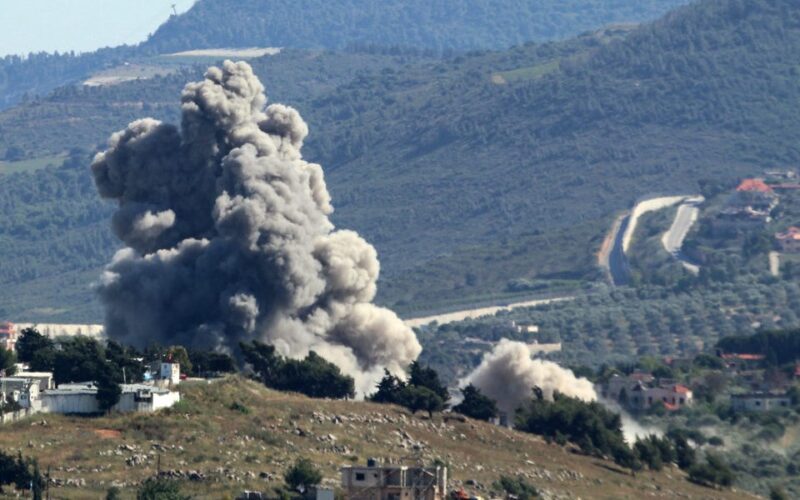Tensions are high at Israel’s northern border.
Israel and Hezbollah, the Iran-backed militant group operating out of Lebanon, have regularly exchanged fire since Hamas staged its cross-border terrorist attack from Gaza into Israel on October 7.
While this tit-for-tat has so far been contained to the border region, it could escalate into a wider war.
Last month, Israel Defense Forces spokesman Rear Adm. Daniel Hagari said Hezbollah’s “increasing” aggression “is bringing us to the brink of what could be a wider escalation, one that could have devastating consequences for Lebanon and the entire region.”
The cross-border fire appears to have intensified, with Israel’s Air Force intercepting a growing number of projectiles and conducting military operations against Hezbollah‘s military bases in southern Lebanon.
If tensions were to spill over into a full-blown armed conflict, Israel would require a greater need for ammunition, putting intense pressure on the West’s already strained artillery production, experts told Business Insider.
And this could have an adverse impact on Ukraine’s fightback against Russia.
“The West is already under significant pressure just to meet the artillery demand for the Ukraine war,” Raphael Cohen, director of the Strategy and Doctrine Program of RAND Project Air Force, told BI.
“So any new conflict, be it in the Middle East or elsewhere, would exacerbate the supply problems here,” he said.
Ukraine could suffer the consequences on the battlefield, according to Kathryn Levantovscaia, a deputy director in the Forward Defense program of the Atlantic Council’s Scowcroft Center for Strategy and Security.
“Redirecting artillery to Israel would significantly hamper Ukraine’s military operations, forcing them to scale back their efforts and ultimately increasing the risk to strategic positions and territory,” she told BI.
Significant pressure on production
The US and Europe have ramped up artillery production rates to try to outgun Russia and meet Ukraine’s battlefield needs.
Europe is making about 600,000 shells a year, per a December 2023 Estonian Defense Ministry report, while the US produced 28,000 155mm rounds in March, with plans to produce up to 80,000 rounds a month by the end of 2024, Pentagon spokesperson Jeff Jurgensen told VOA at the time.
But Russia’s production rates still far outweigh the West’s, according to NATO intelligence estimates reported by CNN in March.
And despite the West’s efforts to boost production, the US and European countries would struggle to keep up with artillery demand in two different wars, experts told BI.
“No one foresaw the war in Ukraine lasting as long as it has, and I don’t foresee Israel backing down any sooner, which means the simple cost of duration will inevitably impose a long-term strain on production,” Levantovscaia said.
Mark Temnycky, a nonresident fellow with the Atlantic Council’s Eurasia Center, said the West’s production capacities were already under pressure when Hamas launched its attack on Israel on October 7.
But if a new war began on Israel’s northern border, the West’s industrial base would be “brought to the test,” he said, with pressure to supply defense equipment to Israel and Ukraine at a faster rate.
According to RAND’s Cohen, “any new demand would compound the supply issues with artillery rounds here.”
However, he noted that Israel would fight a “very” different type of war with Hezbollah than Ukraine is fighting with Russia.
“Israel would rely more on air power, and Hezbollah, in turn, would rely on its fairly significant stockpile of rockets and drones,” he said.
“And so, I don’t think you would see the same number of artillery duels that we see currently in Ukraine.”
Mark Cancian, a retired Marine Corps colonel and senior advisor at the Center for Strategic and International Studies, has a different take.
Sending thousands of rounds to Israel would reduce what is available for Ukraine, but “that would be mitigated by the ongoing increase in production,” he told BI.
“Further, an Israeli conflict with Hezbollah would likely be of short duration, so shipments to Ukraine would return to previous levels when the war in Lebanon ended,” he added.
Ukraine could pay a price
Cancian doesn’t believe that Ukraine would run out of artillery projectiles. But it would need to prioritize targets as it did in the spring, when US supplies were drying up, he told BI.
“That would lead to fewer Ukrainian counterattacks and a more difficult time holding terrain on the defensive,” he said.
Levantovscaia said diverting artillery to Israel could potentially cost Ukraine the war, but said she wasn’t “100% sold,” and that Ukraine’s innovation and determination could counterbalance that.
Cohen of RAND, for his part, said Ukraine has shown itself “remarkably resilient” over the last two and a half years of war.
“Moreover, while the United States would want to support Israel in a war in the north, many European countries would likely still focus defense efforts on supporting Ukraine first and foremost,” he said, “both because they see Ukraine as vital to their national security and because sending arms to Israel is an even more contentious issue there than it is in the US.”
Even so, Temnycky said that any new limits on arms and ammunition would “certainly” make the objective of winning the war in Ukraine harder.
But “Ukrainians have been fighting for true independence from Russia for over 400 years,” he said. “They are determined to keep their freedom, and they will do whatever it takes to ensure that they do not lose the war.”
Source link
lol

